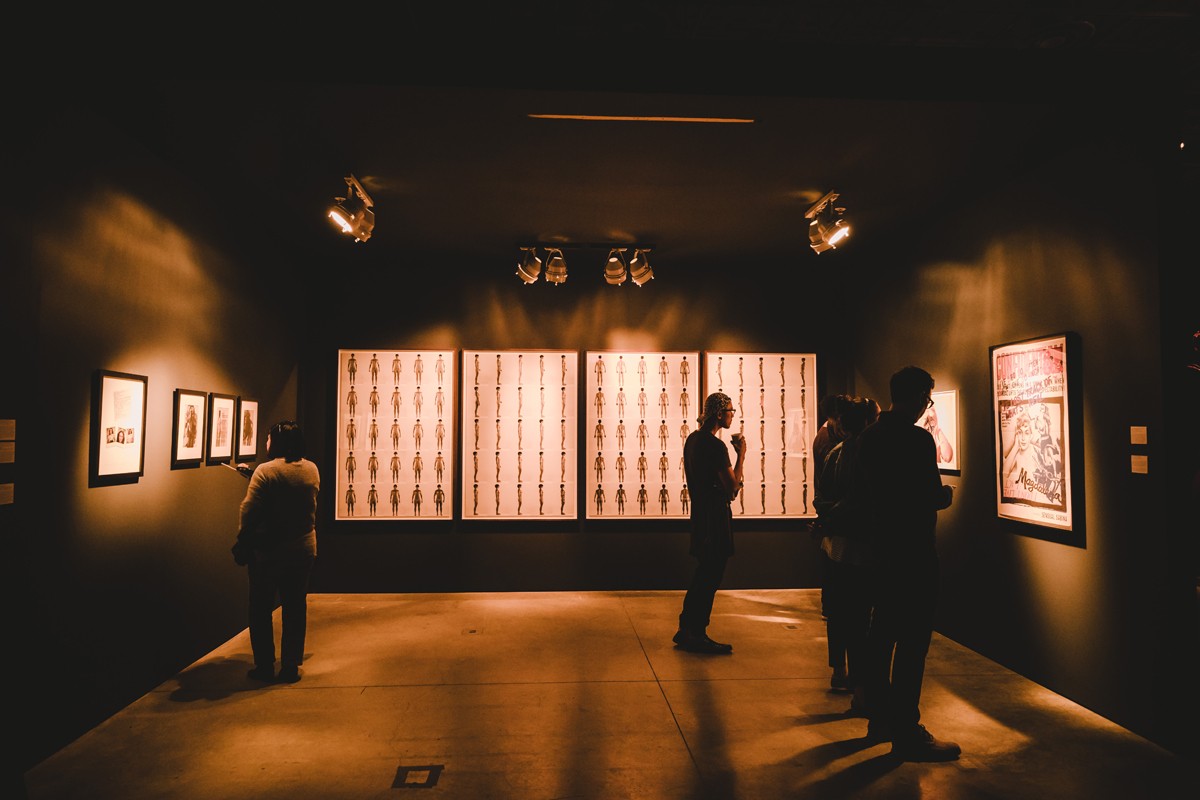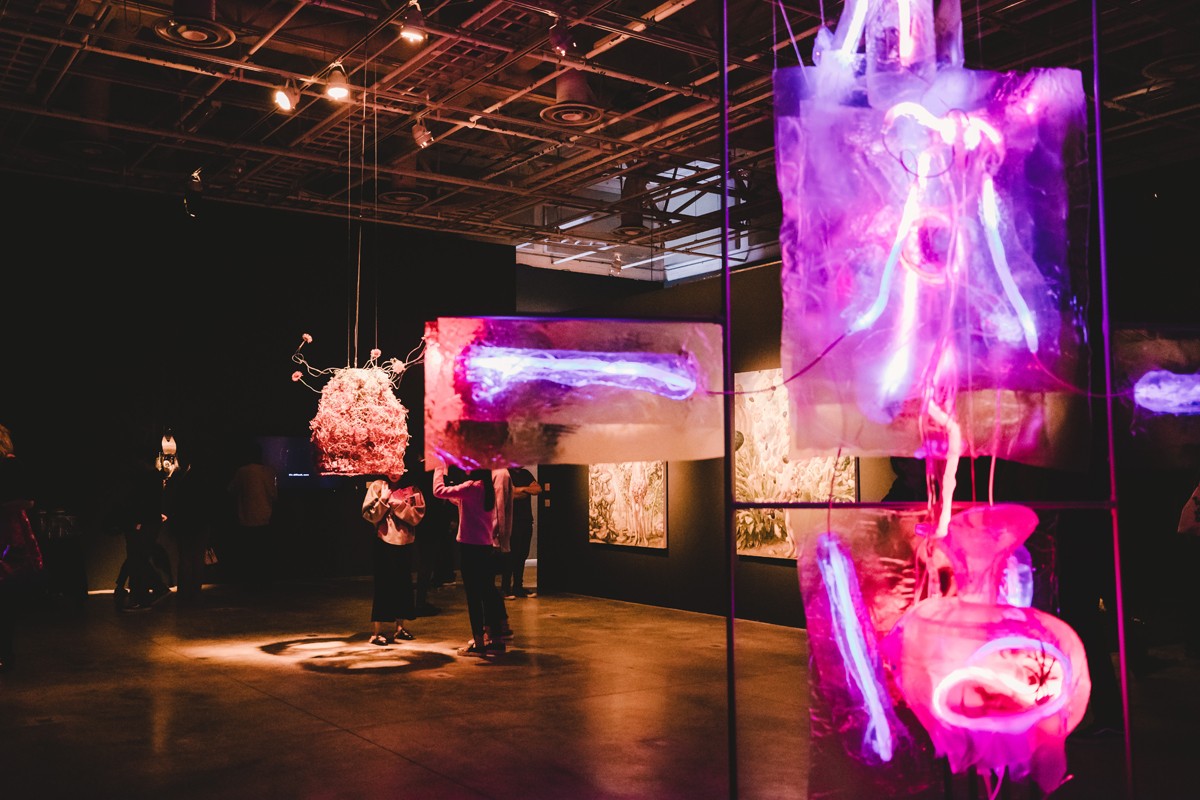
I’m sitting opposite two members of Freewaves, a media-arts organization that’s doing a performative piece about the latest iterations of feminist and gender theory in their project, DIS . . . MISS. The post cards laid out on the table between us are precisely designed, some funny, some obscure, others aggressive. I end up picking a photo of masked indigena activist bicycle club Ovarian Psycos. One of the two artists then documents our discussion in writing, as the other peppers me with questions about how I would “radicalize” or change the image in front of me. I Sharpie a sentence on the back, and we talk about women feeling they have to ask permission, badass grrrls, the alt-right as a hipster movement, and the recent Muslim Ban.
It’s the first night of “Masculine<—>Feminine” at UC Irvine’s Beall Center for Art + Technology. Crowds are awful at openings, it’s difficult to get close to the work without interruption, and meeting artists can be awkward, since they generally don’t know how to talk about themselves or their process. The resulting conversation is usually anything but enlightening, a public-relations spin with few ideas exchanged.
That’s not the case here. Curated by Beall Artistic Director David Familian, with the support of Chapman University professor Micol Hebron, the intermedia show is busy but not crowded, noisy but not overbearing, with intense personal conversation the byproduct of the work. According to the press release, the show is meant to challenge issues of gender in an attempt to provide freedom “from the masculine/feminine binary.” I don’t think the show is successful at following its own intentions, but it still led to two hours of discussion about despair, joy, Donald Trump, liberal Facebook meltdown, activism, the corporate co-opt of our bodies and massive vulvas dispensing piña coladas.

Stephen Kinged in a road accident a couple of years back as he walked across the street, Danial Nord’s polycarbonate castings of his own damaged body compose much of his mixed-media sculpture Sleeper. Within the castings are LEDs that throb like a bloodstream or imply x-rayed bones and Frankensteinian internal organs. Hanging from scaffolding, the sculpture’s enlarged head is tilted at the neck as if its hit the ground, as a steady stream of water pours from the body’s penis into its ear. Heard from speakers is a call and response between the recorded hate speech of Donald Trump—mixed with the sound of very wet farts—and the voice of a Winston Smith stand-in, parroting every word it hears. It’s discomfiting for several reasons: Aside from the piss brain-washing, there’s the image of “the wall” and upended life, crucifixion overtones reminiscent of Saint Paul, and the polycarbonate itself, making the body look fresh from a butcher shop, carved, sealed in plastic and ready for the freezer.
The pseudonymous Sputniko! is a Japanese/British critical-design artist whose Menstruation Machine resembles a space-age chastity belt. Its sleek edges are a shiny torture device, made for men to wear, that simulates the experience of a woman having her period. Electric stimulation forces muscle cramps, and there’s a surprise drip of unexpected red fluid designed to stain your clothing. Taken in tandem with the accompanying music video—in which the artist is dressed as a boy, puts on female drag and the machine, and then goes on a date with a girl—it’s one of the few pieces in the show that’s overtly confrontational about gender. Besides the Freewaves piece, the only other work that really approaches this is trans artist Cassils’ series of archival pigment prints, Time Lapse (Front), Time Lapse (Back), Time Lapse (Left), Time Lapse (Right), documenting the physical transformation when a weight gain and weight-training regimen radically sculpts a softer “feminine” body into a muscular, more “male” form.
I watched several people as they entered their information into the Bodies INCorporated website and created digital avatars of themselves. Looking like the heroic mutants of X-Men, the avatars can be upgraded as earthly bodies decline, and if artist Victoria Vesna has her way, our ideal artificial bodies will be around in a database long after we’re gone. As she walked me through her backhanded ode to New Age capitalism, she talked openly about trying to create something that could be seen, even make money, outside of a gallery. I’m not sure how it will play without her there—a URL instead of the computer will be there for future patrons—but the conversation was as witty and light as could be, considering that our conversation was about our own eventual deaths.
If the raft of ideas and imagery makes the show successful as an art exhibit, it fails at consistency of theme: Each of the works on display has its own agenda, so trying to shoehorn the work into a single political-slash-ideological category is an act of futility. What’s missing is more androgyny, the blurring of the two sexes. That riskier, more uncomfortable, harder to pinpoint, queerer discussion is what much of the show approaches, but then steps away from, falling back into safer, more traditional concerns.
“Masculine<—>Feminine” at Beall Center for Art + Technology, Claire Trevor School of the Arts, 712 Arts Plaza, Irvine, (949) 824-6206; beallcenter.uci.edu. Open Tues.-Sat., noon-6 p.m. Through May 13. Free.
Dave Barton has written for the OC Weekly for over twenty years, the last eight as their lead art critic. He has interviewed artists from punk rock photographer Edward Colver to monologist Mike Daisey, playwright Joe Penhall to culture jammer Ron English.

